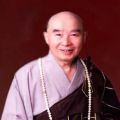When we recite morning and evening ceremonies in front of the Buddha and Bodhisattva images, it is just as if we were vowing to abide by their teachings right in their presence. Morning recitation acts as a reminder, preventing us from forgetting the Buddha's teachings, and reminding us to act accordingly in the course of the day. Evening recitation is a reflection of the day's practice, checking to see if we acted according to the Buddha's teachings. If we did, then we can work even harder next time, if not, then we need to reform, seeking to renew ourselves each day. Only by practicing in this way can true benefits be attained. Morning and evening recitations are the most basic practices in learning Buddhism. It is necessary to remind ourselves each day and reflect and reform.
One who wishes to become a student of the Buddha should first learn from Maitreya Bodhisattva, better known in America as “The Happy Buddha.” Maitreya Bodhisattva represents the most basic conditions necessary to become a Buddhist - a smiling face and a big heart, represented by his big belly. All the Buddha images serve to remind us of the teachings and are not idols or gods of worship. “The Happy Buddha” teaches us to give rise to a non-discriminating mind and to be happy; thus being able to enter the Buddha Way.
The content of the Buddha's teachings is infinitely profound and vast; one is unable to speak of it all, for the essence of it is unfathomable. Understanding it can bring great help tour living, work and interacting with all people, matters and affairs. Buddhism truly surpasses the boundaries of nationality, race and religion – it encompasses everything. The Buddha's teaching is truly a perfectly complete education.

